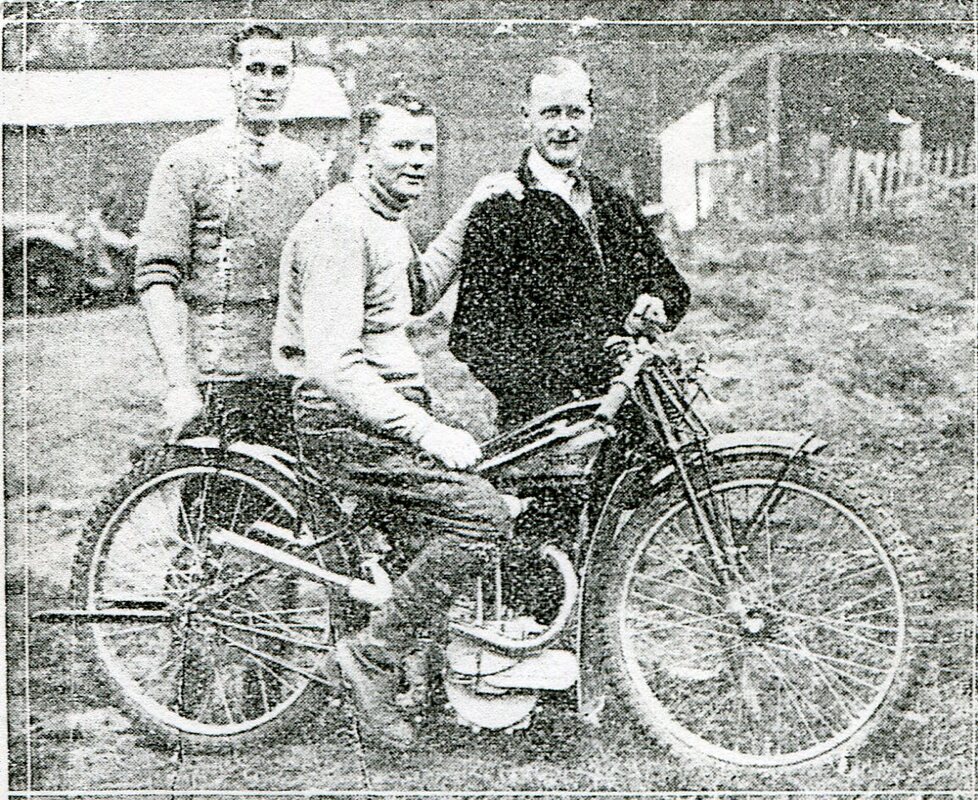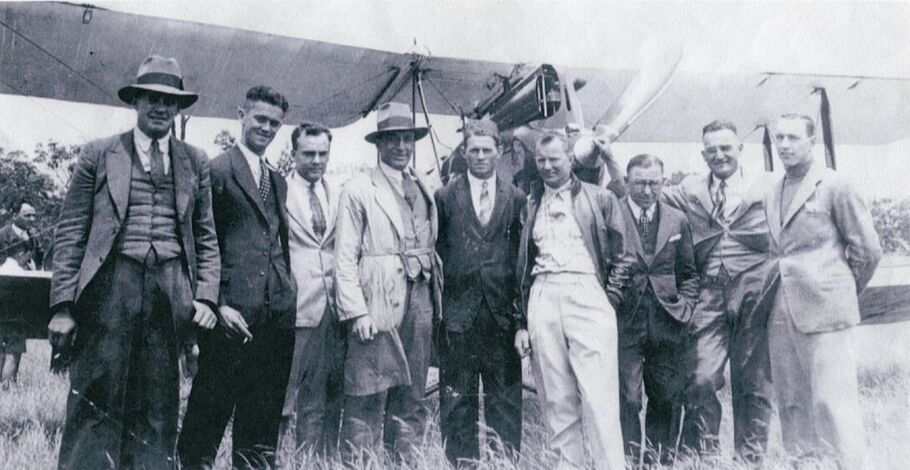BUNBURY (WA)
*********************************************************************************************************************************
1927 - STAN CATLETT
Not many would be familiar with the tragic plane crash at Picton in 1933,that claimed the lifes of two young Bunbury men, Colin Teede and Stan Catlett, but very few would know of the adventurous life of the twenty six year old Stanley Waldo Catlett.
Stan was born in 1907, the second son of Mr and Mrs Ernest Waldo Catlett. Catlett Snr was a jeweller and watchmaker, who lived and conducted his business from premises in in Wellington Street roughley were Souths Furniture store is today.
Stan served a mechanical apprenticeship and by 1924 - 1925 worked as a mechanic with the Narrogin Trading Co, who at that time had the Ford dealership.
His scills in tuning and repairing any type of motor was recognised by the motoring public of the day and his services were always in demand.
His obvious love of speed was not only on motorcycles and in motor vehicles, but also in speedboats.The tales of his exploits in scaring the locals on the estuary, from Turkey Point to the Collie River, are still remembered.
In 1927, after completing a number of successful seasons on the Speedway tracks in Perth, he decided to compete on the lucrative Speedway scene in Great Britain, to defray costs, he joined a tramp steamer as forth engineer and after a four month voyage reached Liverpool, He approached the top English club, Wembley, and with borrowed riding gear and riding an unfamiliar club bike, he made his debut, and was soon competing on the English club circuits and adding adding to his reputation as one of the top Australian riders to enter the English speedway circuit.
Stan was born in 1907, the second son of Mr and Mrs Ernest Waldo Catlett. Catlett Snr was a jeweller and watchmaker, who lived and conducted his business from premises in in Wellington Street roughley were Souths Furniture store is today.
Stan served a mechanical apprenticeship and by 1924 - 1925 worked as a mechanic with the Narrogin Trading Co, who at that time had the Ford dealership.
His scills in tuning and repairing any type of motor was recognised by the motoring public of the day and his services were always in demand.
His obvious love of speed was not only on motorcycles and in motor vehicles, but also in speedboats.The tales of his exploits in scaring the locals on the estuary, from Turkey Point to the Collie River, are still remembered.
In 1927, after completing a number of successful seasons on the Speedway tracks in Perth, he decided to compete on the lucrative Speedway scene in Great Britain, to defray costs, he joined a tramp steamer as forth engineer and after a four month voyage reached Liverpool, He approached the top English club, Wembley, and with borrowed riding gear and riding an unfamiliar club bike, he made his debut, and was soon competing on the English club circuits and adding adding to his reputation as one of the top Australian riders to enter the English speedway circuit.
ONE OF WEMBLEY'S LIONS
Our illustration shows Stan Catlett with his mechanic and (right) Mr. Harold Taylor the famous Side Car Specialist.
Racing was conducted over four to five nights a week, consequently prize money earned by top riders amounted to film star status. Catlett was appointed captain of the Wembley side and at the close of the English season returned to Australia with fellow Aussie riders and the English team for a test series in all major cities.
The Perth press made much of Catlett's return as a passenger occupying a stateroom on the P&O liner, in contrast to his departure on a cargo boat working for his passage.
Bunbury folk were out in force to welcome Catlett on his return from England and of course he arrived in style, flying into town in a borrowed aircraft , accompanied by the captain of the English team Jack Ormiston as well as Catlett's Wembley team mate.
Catlett was enjoying another spectacular season when he had one of the worst crashes in his career badly breaking a leg in two places.
After seven weeks of convalescing he finished the season and returned home to Bunbury with funds in his pocket and the desire to open his own business.
Stan continued earning top money as a star attraction at the Claremont speedway, but he must have realised the need to consolidate his life and a decision was made to open his own garage and workshop. he was assisted in his endeavour with the help of the Ramsay family, who were farmers from in the Capel district. They secured land on the South East corner of Stirling and Spencer street and built a garage and workshop for Stan, who had secured the morris dealership for the district.
The Perth press made much of Catlett's return as a passenger occupying a stateroom on the P&O liner, in contrast to his departure on a cargo boat working for his passage.
Bunbury folk were out in force to welcome Catlett on his return from England and of course he arrived in style, flying into town in a borrowed aircraft , accompanied by the captain of the English team Jack Ormiston as well as Catlett's Wembley team mate.
Catlett was enjoying another spectacular season when he had one of the worst crashes in his career badly breaking a leg in two places.
After seven weeks of convalescing he finished the season and returned home to Bunbury with funds in his pocket and the desire to open his own business.
Stan continued earning top money as a star attraction at the Claremont speedway, but he must have realised the need to consolidate his life and a decision was made to open his own garage and workshop. he was assisted in his endeavour with the help of the Ramsay family, who were farmers from in the Capel district. They secured land on the South East corner of Stirling and Spencer street and built a garage and workshop for Stan, who had secured the morris dealership for the district.
The busy period of setting up the business to open in December of 1933 saw Stan off to Perth to secure stock for the dealership and to enjoy a few days break before the big opening day.
Deciding that a good way to relax and enjoy the freedom of the air was to hire an aircraft from the Royal Aero Club (he was a member) and apparently whithout thought to the consequences and without permission decided on a flying trip to Bunbury. that fateful decision was made on the 29th of November 1933 and the rest is history.
Deciding that a good way to relax and enjoy the freedom of the air was to hire an aircraft from the Royal Aero Club (he was a member) and apparently whithout thought to the consequences and without permission decided on a flying trip to Bunbury. that fateful decision was made on the 29th of November 1933 and the rest is history.
(Editorial Ray Repocholi from the book Bunbury i remember when)
The photo above of Jane Motors was taken in 1937, this is the original building that was built for Catlett dealership. currentley in 2011 the building has been replaced with the two story complex that is home for Hot FM.
1933 - Prior to the ill fated flight. Photo: South West Times newspaper.
1933 - The crash scene. Photo: South Western Times newspaper.
The Catlett Story was made possible with the kind assistance of his nephew, Mr Frank Handley, and the family with newspaper cuttings and the family photo's: Ray Repocholi.






